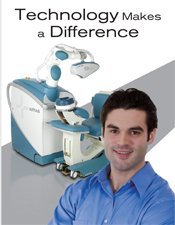Female-Pattern Hair Loss
The most common form of hair loss in women is female-pattern hair loss, which is a hereditary condition also referred to as androgenetic alopecia. While pattern hair loss affects both men and women, it is very different in women and does not display the classic receding hairline or bald spot on top of the scalp as it does in men. In women, the frontal hairline is usually maintained, but there is visible thinning over the crown. In both male- and female-pattern hair loss, the hair stays on the head for a shorter time due to a short growth phase, resulting in baby fine hairs that do not reach their full length or diameter.
Fortunately, several treatment options are effective for women with hair loss. Minoxidil 2% is the only topical medication approved by the U.S. Food and Drug Administration (FDA) for female-pattern hair loss. Minoxidil 5% is only FDA-approved for male-pattern hair loss, but it has been shown to be very effective in women as well. Both the 2% and 5% solutions are available over-the-counter. While minoxidil does not grow new hair, it works by prolonging the growth phase of hair – providing more time for hair to grow out to its full density.
Although minoxidil is an over-the-counter treatment, women should consult their doctor who is experienced with the product and can explain how it works and off-set any known side effects.
In some cases, other medications may be used off-label to treat female hair loss, including finasteride (which is FDA-approved for male-pattern hair loss) for women of non-childbearing age only, and the anti-androgens spironolactone and flutamide that work by blocking the male hormone testosterone at the cellular level of the hair follicle. These oral medications also may be an option for women who may not want to spend time applying minoxidil every day. Dr. McMichael also noted that hair transplantation is an extremely effective procedure for women who want to fully restore their lost hair and works best in conjunction with topical or oral medications to prevent further hair loss.
Low Level Laser Technology (LLLT)

The low- level laser therapy treatment is also known as “The Cold Laser”. The laser light generated by low-powered (cold) lasers has recently come into use as a non-surgical hair restoration treatment for patten hair loss.
The LLLT lasers are called “cold” because their light is absorbed by targeting tissue but does not heat the target tissue as occurs with lasers used to cut and remodel tissue. Instead the laser has an interaction with the living tissue which is defined as photobiology. This laser therapy has been proven to have the best results when combined with other medical therapies such as minoxidil or finasteride. Treatments must be repeated to maintain hair growth and the only permeant treatment for pattern hair loss is still hair transplantation.
The LaserCap® using Low Level Laser Technology (LLLT) can help men and women of all ages who suffer from hair loss by emitting pulses of laser light energy to the scalp to stimulate the hair follicles and improve blood circulation in the area, encouraging hair growth once again.
Recently, the FDA has announced its approval of Low Level Laser Technology for use in the promotion of hair growth for men, with approval for women anticipated soon as well. Dr. Bishara fully endorses the results of this advanced technology and is proud to offer LLLT in his office through treatment with the LaserCap.
During the LLLT procedure, beams of light are absorbed by the scalp to stimulate blood flow and allow more nutrients to flow to the hair follicles. As a result, hair begins to grow again. Many patients experience significant improvement to the amount and quality of their hair after this procedure, and report benefits such as:
- Reduction of excessive hair loss
- Improvement of hair shaft quality
- Repair of damaged hair follicles
- Thicker, easier-to-manage hair
- Reduction of excess oil production in the scalp
- Relief from itchy scalp symptoms
This treatment is non-invasive and is considered safe for most patients, with no known side effects. The technology used during LLLT ensures that no damage will occur to surrounding living tissues, providing maximum results. LLLT has been used in Europe for over 30 years before its recent approval in the US.
Anyone can use the LaserCap. All you have to do is insert the LaserCap into any hat you desire. The cap can fit into any hat large enought to hold it. Then connect a fully charged battery pack in the cap and turn on the power switch. You will see results within 60 days. LaserCap can be used with other treatments such as Propecia.
Robotic Hair Transplants for Men and Women
For the very latest technology in hair restoration, Dr. Mark Bishara is using the ARTAS System. This interactive, computer assisted equipment employs image guidance to enhance the quality of hair follicle harvesting. ARTAS is the first hair transplant robot to improve the most challenging aspects of Follicular Unit Extraction (FUE).
There are two common ways to treat balding including strip harvesting and follicular unit extraction (FUE). Strip harvesting is the most commonly used technique right now, and it is an efficient means of harvesting large quantities of follicles.
However, we have stopped offering it as a primary modality for a number of reasons, including patient recovery time and wound morbidity.

Benefits of ARTAS System
Robotic technology is used in numerous surgical and diagnostic procedures to improve the efficacy of treatments. Restoration Robotics has incorporated robotic technology into FUE resulting in the ARTAS system which is the first and only FDA-cleared technology that allows the physician to control the image-guided robot. I am able to make minor adjustments to dissection depths and angles during the extraction process ensuring my patients receive optimal results.
The ARTAS system also greatly reduces post procedure pain or disomfort as compared to strip-harvesting where patients report a sense of tightness and some degree of numbness for two to three months after a strip harvest.
Before and After Pictures some of our patients:




How the Procedure Works
The patient’s hair is first trimmed before the ARTAS system digitally scans areas of the scalp to identify hair in natural groupings. The selected hair is then precisely harvested using the robot and then transplanted into the thinning areas. These grafts will then grow just like they did before the areas where they are needed to fight balding.
Results will start to show in 3 months and by the 6th month, patients can expect to see noticeable improvements. The hair will continue to grow and full results will be achieved a year after the treatment.
The ARTAS Robotic Hair Transplantation procedure is preferred because of its minimally invasive nature and no need for anesthesia or downtime. This procedure is designed to produce effective results with minimal downtime and no damage to surrounding hair follicles. I will help you determine how to achieve the best possible results. Please contact our office for more information at (817) 473-2120.














